Jesse Ziegler | June 9, 2020
Following up on our test of the European version of the Yamaha Tenere 700 last year (June 2019), we finally got the chance to do a 2021 Yamaha Tenere 700 Review with the US model. Yamaha announced the arrival of date for the 2021 Tenere 700 for the US market and eager fans can expect them in early June.
It’s been over a year since we first published our Yamaha Tenere 700 Review and that’s a long time to wait. I truly believe this is one of the most intriguing adventure bikes to come to the market in a long time. And now it’s here.
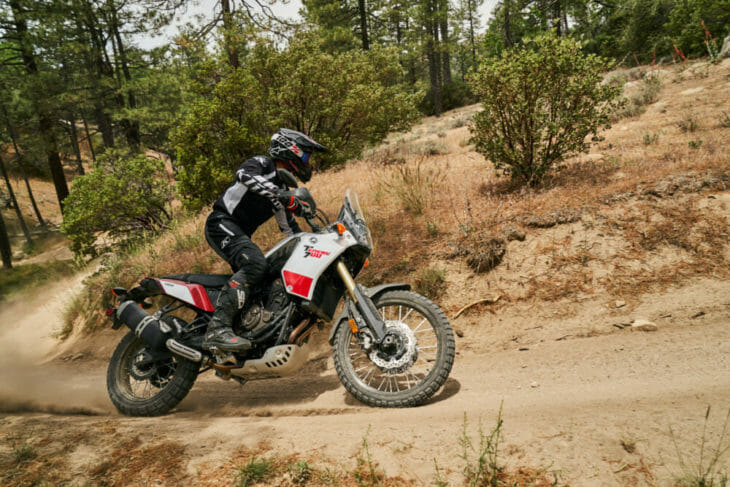 The Yamaha Tenere is finally arriving in US motorcycle dealerships and we have our first test of the US version.
The Yamaha Tenere is finally arriving in US motorcycle dealerships and we have our first test of the US version.
Now that we’ve been able to jump aboard the North American version of the Yamaha “T7”, and it comes into the market at a surprisingly low $9999 price, we think it will prove to be worth the wait.
You can read below in our initial review of this bike all the engine, suspension and chassis specs. You can re-cap the electronics package and all the details that make this bike what it is. Almost all of that is identically the same as the bike you can buy in American Yamaha dealerships. But for this update, we’re focusing on what makes it North American/USA-specific and what, if anything has changed from our European taste in 2019.
2021 Yamaha Tenere 700 USA Specs
The delay in delivery of the Tenere 700 to the United States motorcycle enthusiasts has a few benefits. Sure, you wanted this bike last year, but since the North American Yamaha Tenere 700 is produced in Japan (tooling the plant for its production is the reason for long lead time on delivery), and the European version are produced in Europe, our bikes actually get some updates – and they address some of our only real complaints from European testing.
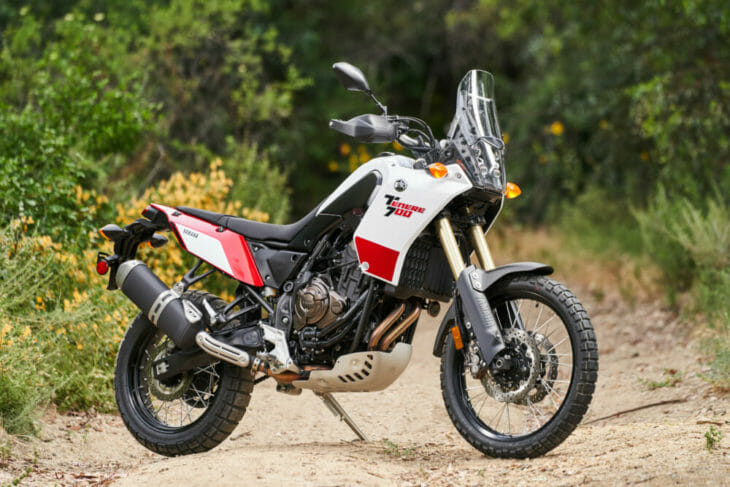 Like the original T7 teased almost five years ago, the Tenere 700 is a great looking bike. Best of all, it works as good as it looks with limited electronics to interfere with your ride.
Like the original T7 teased almost five years ago, the Tenere 700 is a great looking bike. Best of all, it works as good as it looks with limited electronics to interfere with your ride.
Our list of complaints on the Yamaha Tenere 700 was short. First and foremost was throttle response/smoothness. Our European test bike felt abrupt at small throttle openings like the fueling map was not optimized for low-throttle openings and the end result was a hesitation and snap or surge of power that would slap the chain and put a shock into the rear sprocket. This surge or jerking sensation made the otherwise smooth Yamaha Tenere 700 CP2 engine platform oddly awkward and out of balance at throttle roll-on.
For the US-spec bike here, Yamaha has updated throttle mapping and ECU settings to meet fuel and emission requirements here in North America. Also, they specifically addressed the throttle roll-on performance and improved it drastically. Now, the bike accelerates off full throttle stop more consistently and without the hesitant/chunky character we felt in Europe. I crawled up rain-rutted fire roads in first gear and let the rpm chug down in the 1,000 range and the chain stayed tight with each pulse of the 270-degree firing crank. It was absolutely predictable and matched the confidence the rest of the engine’s rpm range performance delivers. On the pavement, the improved roll-on throttle manners were even more welcome.
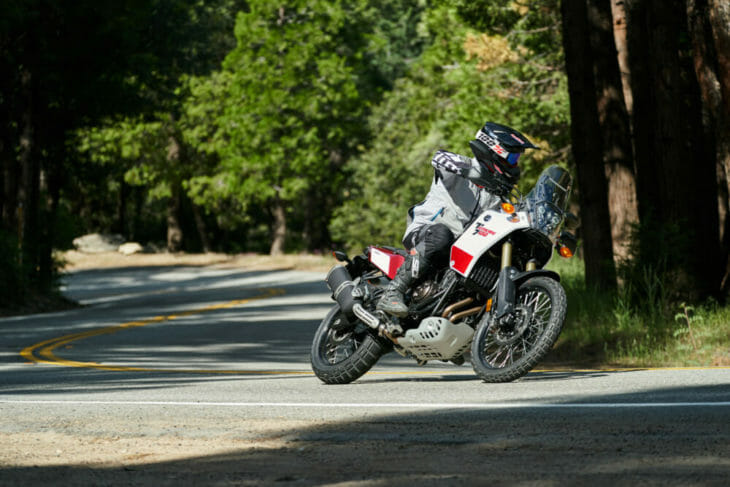 The minor updates made to the US version of the Yamaha Tenere 700 help it perform better on both the dirt and pavement.
The minor updates made to the US version of the Yamaha Tenere 700 help it perform better on both the dirt and pavement.
Our second complaint from Europe was with the Yamaha Tenere 700 braking performance. In Europe, the front brake felt decent but underpowered even for a fairly mellow power delivery. The rear, however, underperformed everywhere. It was hard to modulate and felt like an on/off switch going from rolling to skids without much in-between.
 The rear brake is difficult to modulate and feels like an on/off switch. We noted this during our test of the European model and the US model we rode has the same feeling.
The rear brake is difficult to modulate and feels like an on/off switch. We noted this during our test of the European model and the US model we rode has the same feeling.
We’re happy that the front end of the Yamaha seems to be performing better here in North America. It’s still not the most powerful setup on the market, even though it’s Brembo-badged. But for our most aggressive riding, it was adequate. It is built with some give so new riders or heavy-handed brake squeezers will be saved from unwanted front-wheel skids a bit. For those of you coming off KTM’s, it will feel weaker.
The rear brake is still letting us down a bit. We’d like to upgrade the rear caliper to a four-piston unit or increase the brake hose volume/reduce expansion or build a more rigid rear brake lever—anything to increase the feel and progression/power of the rear brake. It still requires a bit of a stomp to work and goes too quickly from moderately slowing to skidding (with ABS off, of course).
If we’re nit-picking on things, we’re not fond of, we think the minimalist dash is price-appropriate and provides all the info you’ll ever want or need. It’s just hard to read in the daytime, especially when it’s dusty. And I really hope you get this bike dusty.
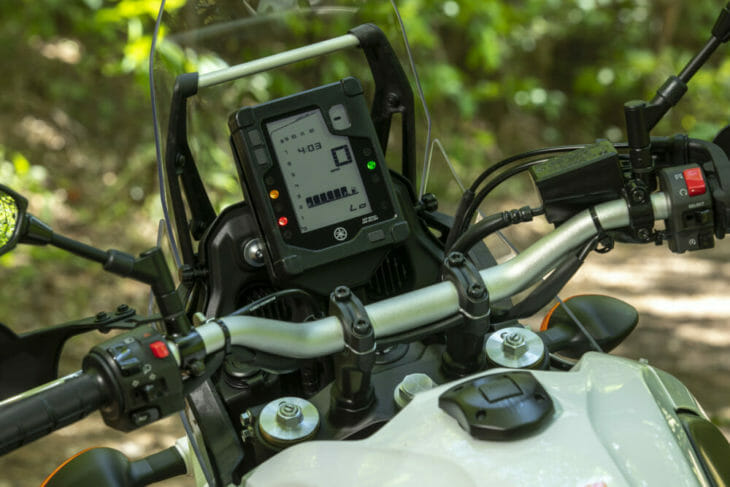 The Yamaha Tenere 700 dash provides the necessary information but it is a little difficult to read in the sunlight and especially when it gets dust on it.
The Yamaha Tenere 700 dash provides the necessary information but it is a little difficult to read in the sunlight and especially when it gets dust on it.
Next, we’d point out the fairly dull footpegs. The “teeth” are more nubs, but they are wide platforms that provide a good foundation. We’re worried about wet weather use or mud evacuation as they don’t have a lot of pass-through in the design.
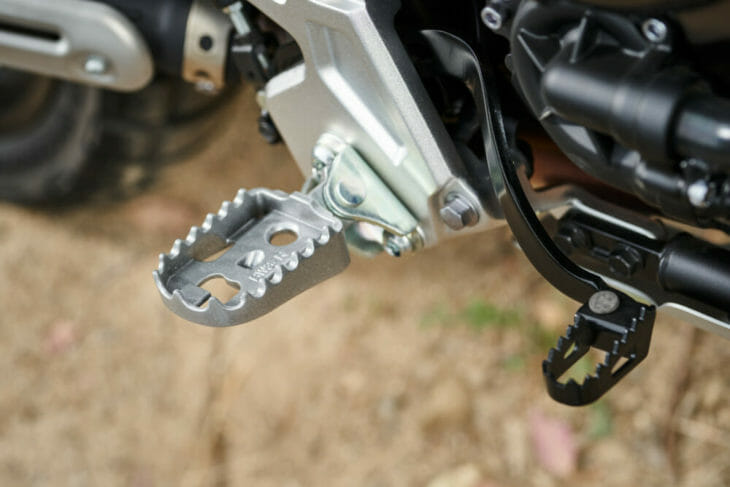 Getting picky, the footpegs could use some sharper teeth and more space to clean out debris.
Getting picky, the footpegs could use some sharper teeth and more space to clean out debris.
Final complaint – obviously it’s the turn signals. Look at those things!? They’re so out-of-place on this bike. We can’t wait to snap them off on some rocks, so we’re forced to replace them with something smaller.
The final big change we felt in the USA-spec Yamaha Tenere 700 was with simple suspension adjustments. Since this bike has been in the hands of the US-based development team, they’ve done a great job of giving us a baseline setting for suspension improvement off-road. In my opinion, the changes made by clickers and knobs improve the ride on-road, too. What’d they do? They went in on everything: more preload on the shock and more compression and rebound damping all the way around. Move the clickers about halfway to full stiff and you’re about right. You can adjust from there for personal preference.
I’m especially pumped on this bike’s ability to adapt to more off-road focused performance and sort of stand up on its own a little with simple clicker changes. I feel like the Tenere 700 is a bit too laid back with too light of a front end feel for precise, aggressive riding in all-terrain (including street). But with the clicker changes and the factory accessory rally seat (places you 41mm higher so you’re on top of the tank/over the bars a bit more), the bike really comes alive and responds with more precision on the front. In stock trim, you will experience a vague front-end feel. Add some rear preload and it starts to bite.
The Best of The 2021 Yamaha Tenere 700
Apart from the ECU change being a huge improvement, most of our first review impressions on the European version are intact with the North American version of the Tenere 700. This bike is an accessible adventure steed that will inspire you to go places. And that’s the point. It is not full of fancy electronics or systems, but it’s more of a classic dual-purpose machine that wants you to explore with it. It comes with tubes in the tires – which should tell you something about where you should ride it and how sophisticated you should act while riding it there.
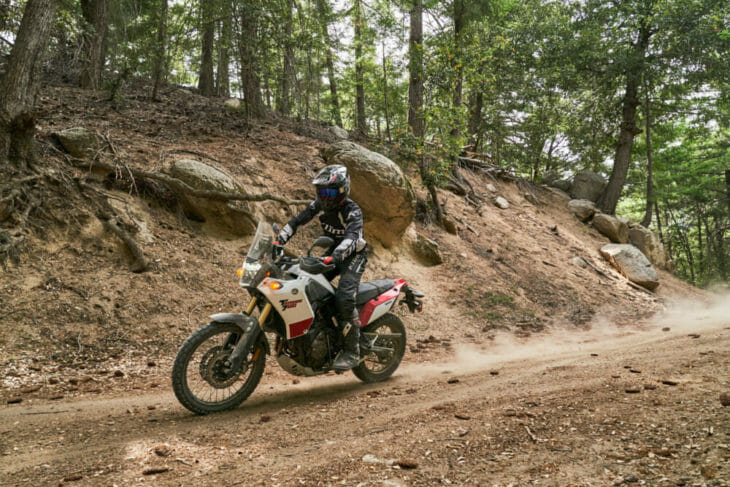 The 2021 Yamaha Tenere will attract many with the relatively low price tag but will win them over with real-world performance.
The 2021 Yamaha Tenere will attract many with the relatively low price tag but will win them over with real-world performance.
Its engine performance steals the show with a loving growl and gobs of traction that makes riding the bike easy. It’s narrow all the way down the lower lines of the bike making obstacle squeezes a breeze. And the bike seems to have real world-travel chops with straight-line sitting comfort being pretty great.
The Yamaha Tenere 700 is not intimidating. It is capable. And we can’t wait to see where $10K can take us this year as we put it head-to-head against the best adventure bikes in the class.
Look for more updates, comparisons, and answers to your Yamaha Tenere 700 questions coming soon.
Yamaha Tenere 700 Review – European model
This review was originally published on June 3, 2019. The Yamaha Tenere 700 is not here in the U.S. yet, just to be clear. But we went to Spain to ride it. Check out our first Yamaha Tenere 700 Review.
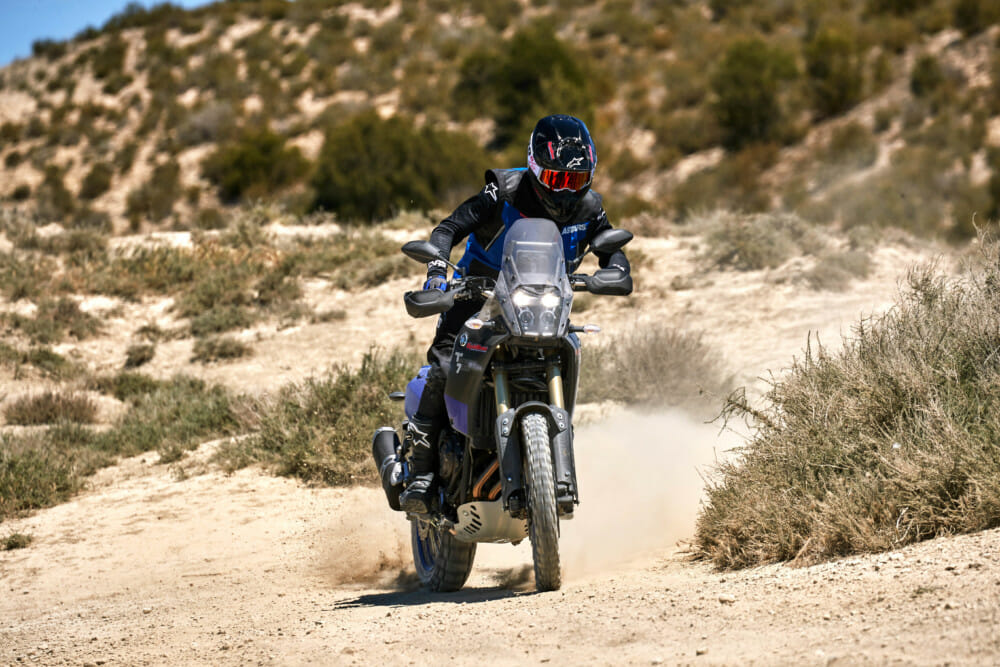 Mid-size ADV bikes like the Yamaha Tenere 700 are what the buying public says they want…are they?.
Mid-size ADV bikes like the Yamaha Tenere 700 are what the buying public says they want…are they?.
We know you’re growing impatient, and we can’t blame you. We are, too! The Tenere 700 represents a lot of great potential for the future of adventure land wrapped in a dependable, affordable Yamaha blanket.
For us in North America, we have it a lot worse than the rest of the world. First, we never got to buy the Yamaha Tenere 660 that was completely new in 2008. So, we essentially missed all things mid-sized and Yamaha, as far as adventure is concerned. Second, we don’t get this one until the second quarter of 2020, at best, as a 2021 model.
However, we did just return from two days riding the European 2020 model, and we can’t wait to tell you all about it.
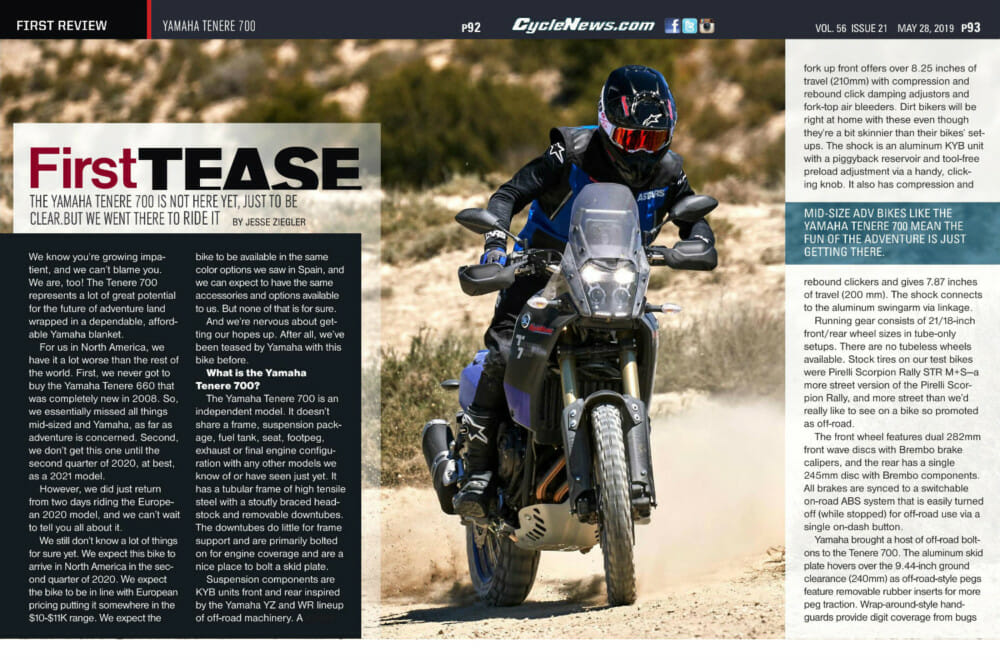
By Jesse Ziegler
We still don’t know a lot of things for sure yet. We expect this bike to arrive in North America in the second quarter of 2020. We expect the bike to be in-line with European pricing putting it somewhere in the $10-$11K range. We expect the bike to be available in the same color options as we saw in Spain, and we can expect to have the same accessories and options available to us. But none of that is for sure.
And we’re nervous about getting our hopes up. After all, we’ve been teased by Yamaha with this bike before.
VIDEO | Yamaha Tenere 700 Riding Review
What is the Yamaha Tenere 700?
The Yamaha Tenere 700 is an independent model. It doesn’t share a frame, suspension package, fuel tank, seat, footpeg, exhaust or final engine configuration with any other models we know of or have seen just yet. It has a tubular frame of high tensile steel with a stoutly braced headstock and removable downtubes. The downtubes do little for frame support and are primarily bolted on for engine coverage and are a nice place to bolt a skid plate.
Suspension components are KYB units front and rear inspired by the Yamaha YZ and WR lineup of off-road machinery. A 43mm fork up front offers over 8.25 inches of travel (210mm) with compression and rebound click damping adjustors and fork top air bleeders. Dirt bikers will be right at home with these even though they’re a bit skinnier than their bikes’ setups. The shock is an aluminum KYB unit with a piggyback reservoir and tool-free preload adjustment via a handy, clicking knob. It also has compression and rebound clickers and gives 7.87 inches of travel (200mm). The shock connects to the aluminum swingarm via linkage.
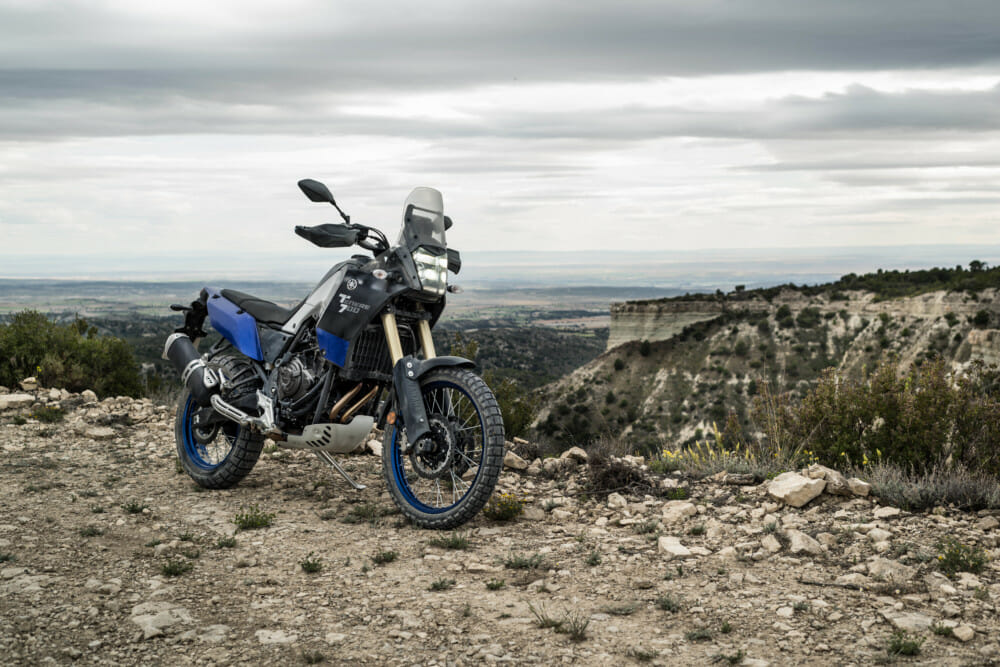 No frills and simplicity is what the Yamaha Tenere 700 is all about.
No frills and simplicity is what the Yamaha Tenere 700 is all about.
Running gear consists of 21/18-inch front/rear wheel sizes in tube-only setups. There are no tubeless wheels available. Stock tires on our test bikes were Pirelli Scorpion Rally STR M+S—a more street version of the Pirelli Scorpion Rally, and more street than we’d really like to see on a bike so promoted as off-road.
The front wheel features dual 282mm front wave discs with Brembo brake calipers, and the rear has a single 245mm disc with Brembo components. All brakes are synced to a switchable on-road ABS system that is easily turned off (while stopped) for off-road use via a single on-dash button.
Yamaha brought a host of off-road bolt-ons to the Tenere 700. The aluminum skid plate hovers over the 9.44-inch ground clearance (240mm) as off-road-style pegs feature removable rubber inserts for more peg traction. Wrap-around-style handguards provide digit coverage from bugs and the occasional tip-over (I would know). Wrapping up the highlights is an adjustable-height front low-fender and smartly integrated hand-holds under the rear fender for maneuvering the bike around.
Fuel capacity it healthy at 4.2 gallons for an efficient use range estimated at over 200 miles between fill-ups. Our quick test calculations backed this up on one fill-up during our day-and-a-half test ride.
Seat height is an approachable 34.5 inches on the stock model. Yamaha Europe showed lower seats and a lowering shock linkage as well as a taller “Rally” seat to fill in the gaps in user preference there.
Finally, the engine is Yamaha’s CP2 unit pulled straight out of the MT-07 street machine.
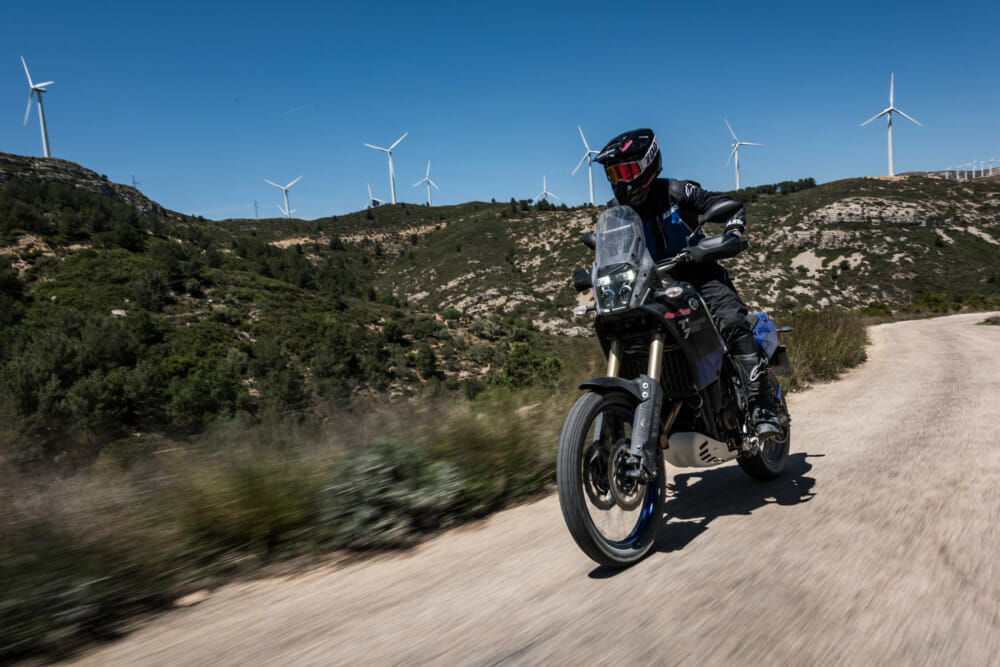 The Tenere is far from intimidating.
The Tenere is far from intimidating.
Yamaha Tenere 700 Engine
The Yamaha Tenere 700 is powered by the finely capable CP2 engine made famous by the MT-07 street bike. The parallel twin isn’t overly sophisticated but offers healthy torque and good power out of its mid-sized displacement.
The Tenere’s CP2 comes tuned specifically to flatten the already broad torque curve of the cross-plane-firing unit. This firing arrangement has been proven in past Yamaha Dakar bikes, sport bikes, and naked street machines and provides great traction feeling, clean torque and a super cool sound. The engine also features Tenere-specific tuning to encourage peak power to hold on longer through the RPM range. The Yamaha Tenere 700’s power output is rated at right around 72 horsepower at 9000 rpm and 50 ft-lb of torque at 6500 rpm (again, European specs).
Numbers aside, the key character trait for the Yamaha Tenere 700’s CP2 engine is usability. It does not intimidate or have so much power potential to throw less-experienced riders into trouble through aggression. It is healthy, and with a good bark out of the stock muffler, we were happily surprised with the engine package as an ADV offering. From loose rocky roads to open gravel and back to the highway, the engine performs well. It’s smooth and balanced from lugging to over-revving.
It’s this friendly nature that backs up Yamaha R&D’s decision to forgo electronic rider aids on the Tenere 700. The CP2 engine is so torquey, smooth and robust—and very controllable, they say—that there is “no need for electronic support.” That’s a direct quote from Takushiro Shiraishi, Project Leader/Division Manager Engineering Division Yamaha Motor R&D Europe.
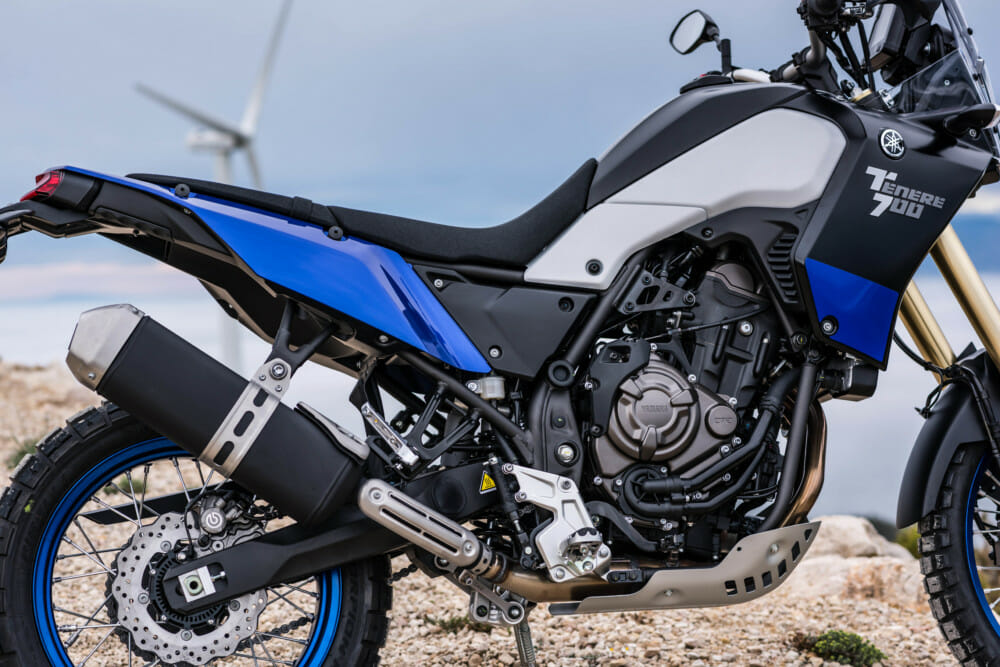 The Tenere 700 is powered by the finely capable CP2 parallel-twin engine made famous by Yamaha’s MT-07 street bike.
The Tenere 700 is powered by the finely capable CP2 parallel-twin engine made famous by Yamaha’s MT-07 street bike.
In addition to fueling and ECU tuning to make the CP2 engine even more suitable to ADV-duty, the power system features a few more customizations that make this truly a unique-to-Tenere platform.
A dedicated off-road style exhaust system keeps the MT-07 downpipe header style and blends a rally-inspired high-pipe muffler exit, a dedicated under seat airbox optimizes fuel flow into the engine to feed the algorithms the right amount of O2 and elevates the airbox out of river-crossing’s danger zone. A higher-capacity cooling system is fitted to keep the bike cool in the slower going of off-road, and the final drive ratio on the sprocket tooth counter is 15t/46t.
During our day-and-a-half aboard the Tenere 700, the CP2 engine was the star of the show. It really is a blast to ride and seems a perfect choice for an all-terrain fun fest. The motor barks off-idle with a healthy, I’ll-have-rocks-for-lunch growl. It pulls so nicely through the bottom and midrange, and the top-end doesn’t disappoint for overtaking the occasional Iberian ham-ladened livestock truck. It’s certainly not a horsepower monster, but it does have ample pull and excitement to keep things lively even though you can tell it’s entirely engineered to be a smooth operator.
We pulled the rubber out of the footpeg right away—after all, we’re super cool off-road guys, and the motor’s vibration is not an issue even in full enduro mode (sans rubber in pegs). The harmonics of the engine are there, just not in an annoying frequency and they certainly don’t thump you to death on a long day.
In off-road scenarios, the engine can clearly shine. We were undoubtedly traction-challenged due to the more road-oriented Pirelli Scorpion Rally STR M+S on the dry, loose roads of Catalunya’s countryside. But even so, the motor will let you kill RPM at the throttle hand and grunt around with heavy clutch work in search of traction like a champ.
On the road, the bike easily chowdered through hairpins in third gear for miles, a testament to a healthy, broad torque curve from an unintimidating powerplant. Yet, it also didn’t mind clicking through the gears and carrying higher revs into the same tarmac slathered corners in second. The engine is sort of a do-it-all performer without a ton of over-excitement.
The only negative we could find with the engine performance was the initial throttle control/engagement of power through the drivetrain. It felt as if there was excessive drivetrain lash, harsh clutch engagement, or an overly abrupt EFI fueling surge causing a jerking sensation through the chassis. The bike showcases such usable and useful power that this sort of snap at initial throttle input seemed really out of place. A little fine-tuning here could be in order to dial in the smoothness of throttle control to match the rest of the engine’s high marks. We snuffed it out with clutch drags, and it was gone. So, we know it can be a little better without dragging the plates.
This is shaping up to be a really great mid-size engine choice or the ADV segment.
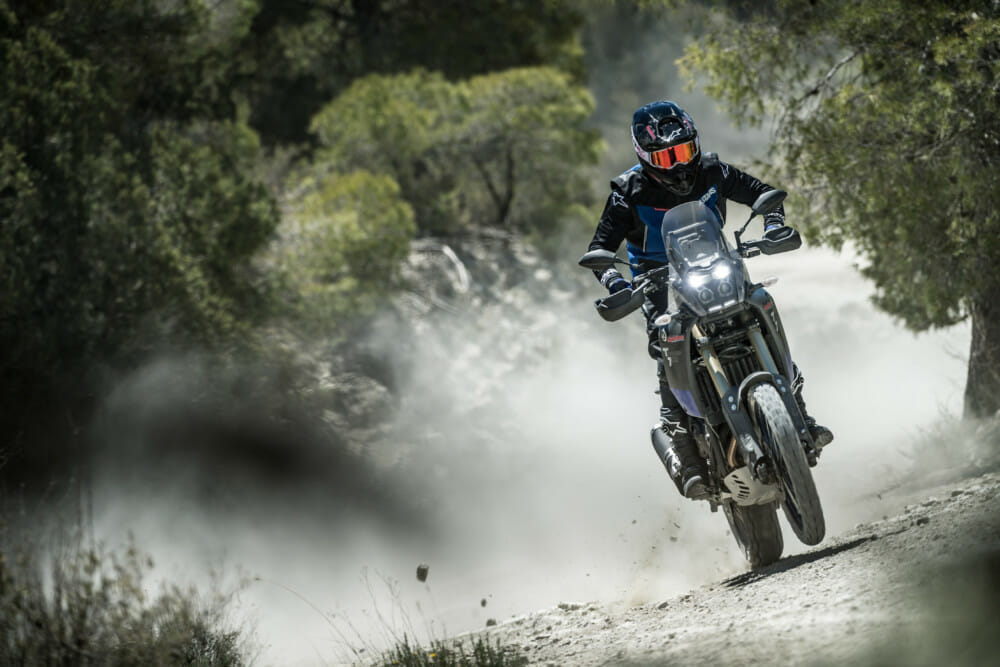
Yamaha Tenere 700 Suspension and Chassis
Overall, the KYB suspension components on the Yamaha Tenere 700 are up to the task of everyday adventuring. They show their limits when the going gets fast, and the bumps get bigger—warning you of impending doom if you don’t slow your damn dirt-bike self down. There’s a smart train of thought that says if your adventure bike is bottoming, it’s trying to tell you something. This bike certainly tells you something before you end up in a pile of dirt. We wish it told us a little bit later.
The chop-gobbling is top-notch for road stutters on pavement and washboards on the dirt. The suspension just eats it up with plush performance. With bigger drops than a standard dirt-road water bar, you’re going to tax the stock suspension settings we rode. The bike, even when pushed to the limit, does stay straight nicely. That’s a testament to a solid frame and swingarm marriage and the beauty of a parallel twin. Never did we feel a harsh or out-of-place characteristic of the chassis.
The 48/52 front/rear weight balance is very noticeable. We took some turns into the shock preload in search of more front tire bite, and it helps a bit. We look forward to seeing what the North American bike specs come in with as far as spring rates and valving. We could see a bit more substantial settings front and rear for off-road and street fans. As it sat in Spain, the front end was looking for bite. You can even see it dancing for traction in the slow-motion video sequences.
For road warriors, you are going to be pleasantly surprised by the corner handling of these 21-inch front-wheeled machines. It has real street cred and backs up straight-line stability with an incredibly agile side-to-side flick factor. If you need to tip it from peg-to-peg, simply stomp on the pegs and lean, the bike readily reacts.
Add a little front wheel traction, possibly a rear shock spring rate upgrade, and a bit more progression in its resistance to bottom out, and this suspension/chassis package will be one of the best going on an adventure rig.
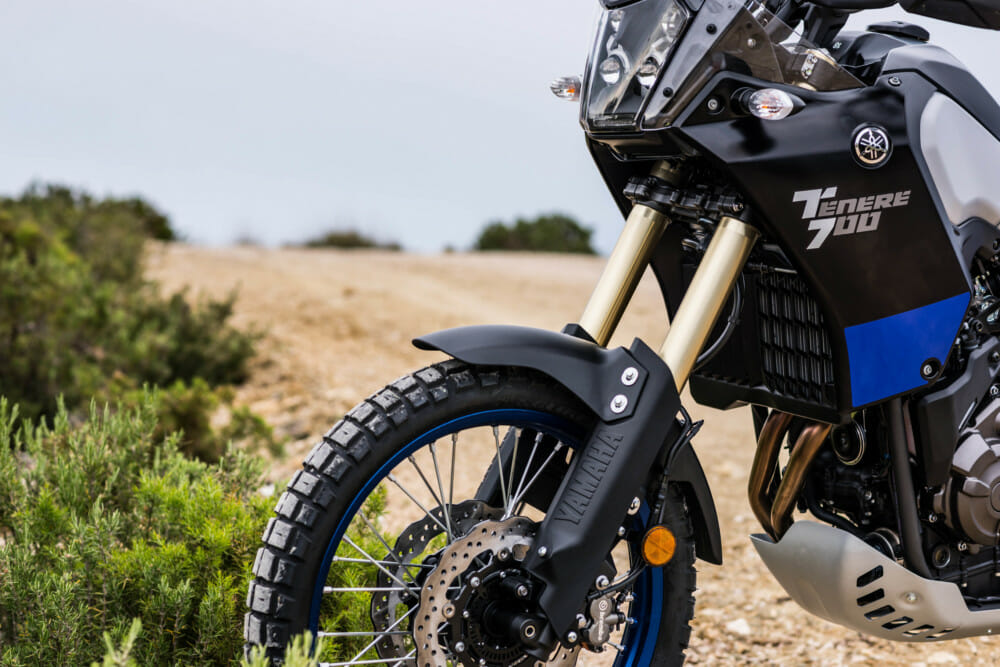 KYB components handle suspension duties. Forks are fully adjustable.
KYB components handle suspension duties. Forks are fully adjustable.
Yamaha Tenere 700 Traction Control and ABS
We already mentioned it, but it’s worth calling out again. There is no traction control or anything like it on the Yamaha Tenere 700. Nothing to learn here. No fancy abbreviations or engineering lingo or traction-power-torque-vectoring-spin algorithms on this ride. It simply doesn’t exist. Traction control is self-imposed, self-regulated and, failures of traction will be undeniably self-inflicted with the Yamaha Tenere 700.
To Yamaha, adding rider aids is unnecessary. It adds complication to a simple-by-nature machine. And for a motorcycling niche more famous for how much crap you can add to a motorcycle than for how well the bike performs on its own, it’s sort of refreshing not having to worry about what mode you’re riding in. However, all of the journalists I rode with and spoke to mention how they are clearly taking electronic rider aids for granted and not having them on the Tenere was sort of an odd feeling.
There is a standard on-road ABS system, and the bike is obviously fuel injected, but that’s about it for electronic gizmos running the show of go here.
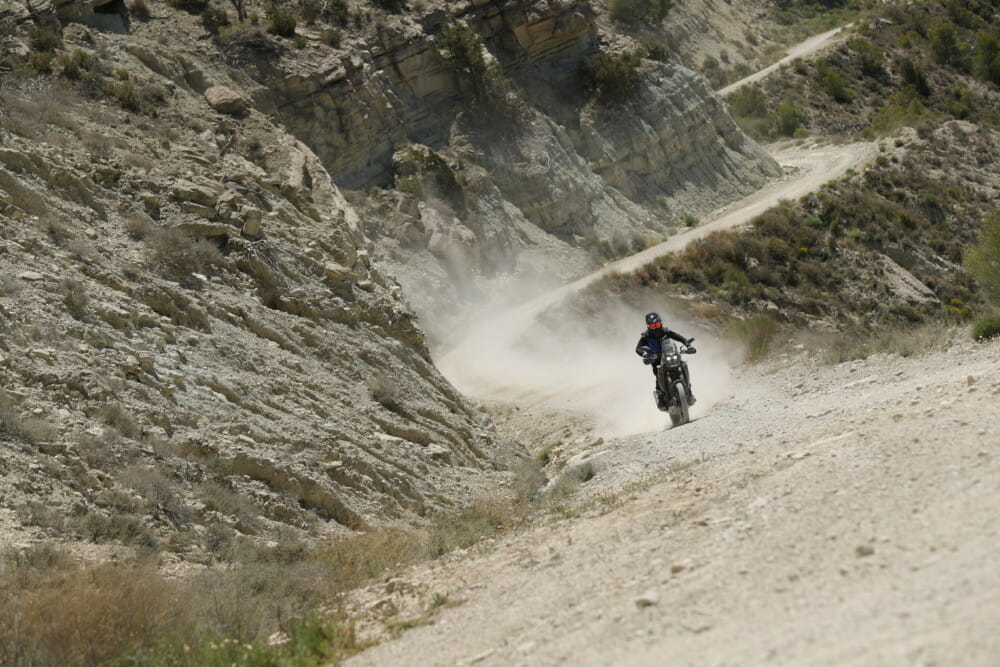
Yamaha Tenere 700 Brakes
Since we’re talking about things that keep you out of trouble, now is a good time to get on the stoppers. The Yamaha is one of few Japanese machines we’ve ridden from the factory with Brembo brake components. Commonplace on Austrian’s models, the Brembo units are usually class leaders in power, feel and durability of consistent braking performance. Unfortunately, the brakes are one of the few things on the Tenere 700 we’re not thrilled about.
The front dual-caliper set up has good feel initially but lacks the uptick in progression that gives us the confidence to brake late or get over-confident in must-stop off-road situations. We’re used to making small movements with the lever to make noticeable changes in speed, and the setup on the Yamaha requires more movement with less change. The brake lines may be flexing, robbing some hydraulic power, or other factors may be at play. Whatever it is, adding some power up front overall wouldn’t hurt our feelings.
On the rear, the brake just needs some progression. As it rides now, the rear brake feels wooden, with no bite at all and then suddenly locks up after quite the pedal throw. It goes from very little slowing power to shuddering the ABS in an instant and, when off-road with ABS disabled, it goes from rolling to instant slide.
To Yamaha’s defense, everyone who listened to our braking complaints replied with a theory stating the non-aggressive braking performance was very possibly built-in to the bike on purpose, to give overzealous brake grabbers and less experienced riders more wiggle room before locking up and sliding down—especially on the front end.
New riders may appreciate this safety net. We didn’t.
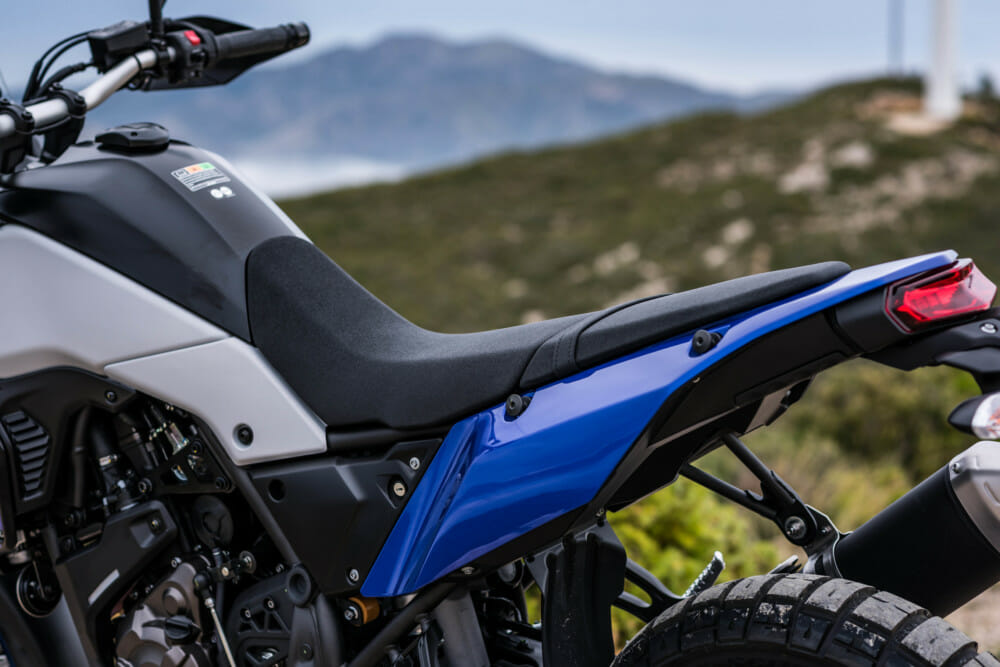 The thin seat doesn’t look all that comfortable but it is.
The thin seat doesn’t look all that comfortable but it is.
Yamaha Tenere 700 Weight
One of the most attractive things about mid-size ADV bikes is their potential to be lighter weight and certainly lighter feeling, without sacrificing overall long-distance comfort. The masses assume, if engineered properly, a lighter adventure-class motorcycle could be a better overall choice for them and make adventuring a whole lot less scary than with big bikes.
Yamaha worked pretty hard to keep the weight down on the Tenere 700, and their provided stats put the Yamaha Tenere 700s weight right at 450 pounds full of fuel. This weight is distributed in a way to boost rider confidence and provide a light and dynamic feel—again, focused on off-road performance first. The result is a 48/52 front/rear weight balance. A light handling front end and ample rear traction are the goals.
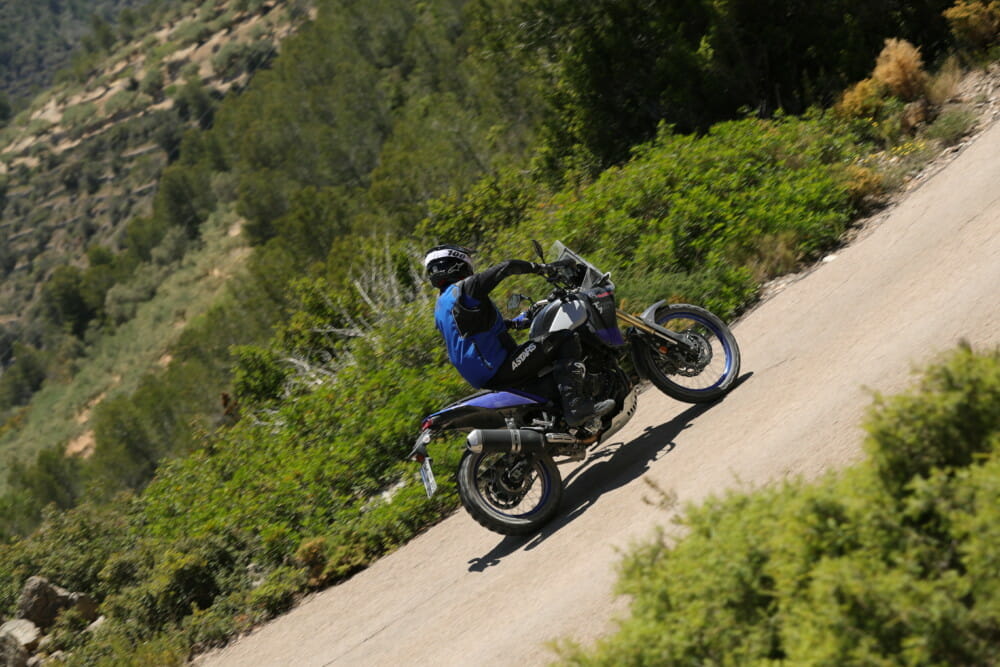
Yamaha Tenere 700 Instruments and Controls
As there are minimal electronic options to scroll through, the instrument cluster and accompanying switchgear populating the Tenere 700’s cockpit is minimal. There is one button on the throttle side controls to cycle through instrument panel displays of trip meters, and fuel consumption data and the same button resets those.
These are all the buttons you can play with on this bike: a kill switch, turn signal control, horn, starter button, instrument panel control switch (one on the bar and two on the dashboard itself), hazards button, high/low beam switch and a light-flash trigger, and that’s all. There are no joysticks or trackballs.
 No space shuttle instruments here. Just the basics.
No space shuttle instruments here. Just the basics.
The cockpit does include a 12v power socket to charge your phone/GPS unit, and the instrument cluster is actually very nice. It has a gear indicator up top, a sort of funky wrap-around digital tach, a big/bold speed number, and a bar graph fuel gauge. It’s not full-color, and the black trim around the screen seems a little close to the numbers at speed, but in general, it’s very adequate.
The Tenere 700 does have two fuel consumption readings. One is average, and one is “real-time.” We’d love a distance to empty reading like the Honda CRF450L and CRF450X have added here.
At your left fingertips, you’ll find a cable-actuated clutch. From zig-zagging through villages to high-speed open stretches and slow off-road abuse, the clutch never flinched or faded. The right side features a cable-actuated throttle that is heavier in pull-back compared to the ride-by-wire units becoming more common on adventure bikes. Its input is direct, however, and we didn’t feel any lag or strange delays. If anything, the throttle control is a little touchy off-idle, as we’ve mentioned already.
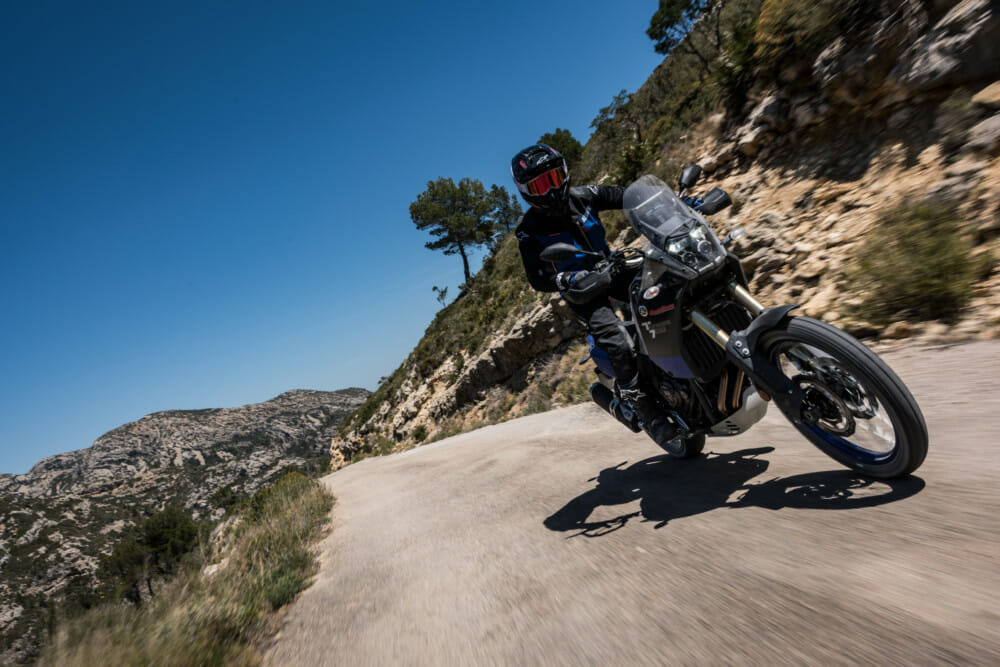
Yamaha Tenere 700 Styling
Yamaha simply dominated the rally-style look on the Tenere 700. The headlight fairing and windscreen tower are cut straight from current rally bike profiles, and it actually works at blocking wind without looking like a snow shovel in front of you. Their styling is modern, but somewhat of a throwback to the baddest dirt bikes ever created. Inside the fiberglass, composite fairing sits an ultra-cool four-LED headlight with an LED marker light underneath. We never know how these things work out when they come to the U.S. with the DOT laws and such, but we’re hoping it’s unchanged because it’s damn-near perfect looking to us. Sitting in the cockpit you can really see how simple this machine is. It’s down to the essence of motorcycling, and if you’re not spoiled by rider aids, you’ll be right at home.
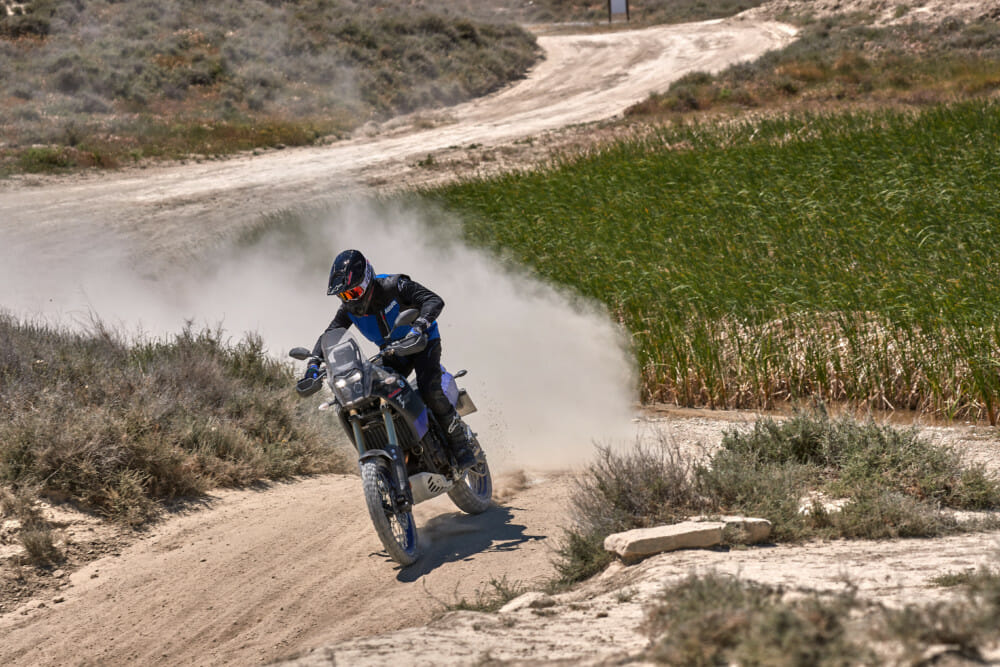
Yamaha Tenere 700 Complaints
We’ve mentioned the soft-ish braking performance and bit of need for more suspension vitality for the more aggressive off-roaders inside us. But what about all our other complaints? We’ll put them here.
First, we are super bummed we have to wait another year to try this bike again. Couldn’t let that go.
Second, we wish the footpegs were longer. They’re actually plenty wide, but we could use them to clear away from the frame a few more mm’s. The clutch housing on the right side of the engine really pushes your leg out when standing, and the peg platform real estate simply runs out.
We inspected the skid plate coverage while crawling around on the ground under the bike, and while it’s nice, it could use some more protection to the oil pan and protruding oil filter—both of which sneak below the lower bolt-on frame rails a bit.
That’s about it for the boo birds on this one.
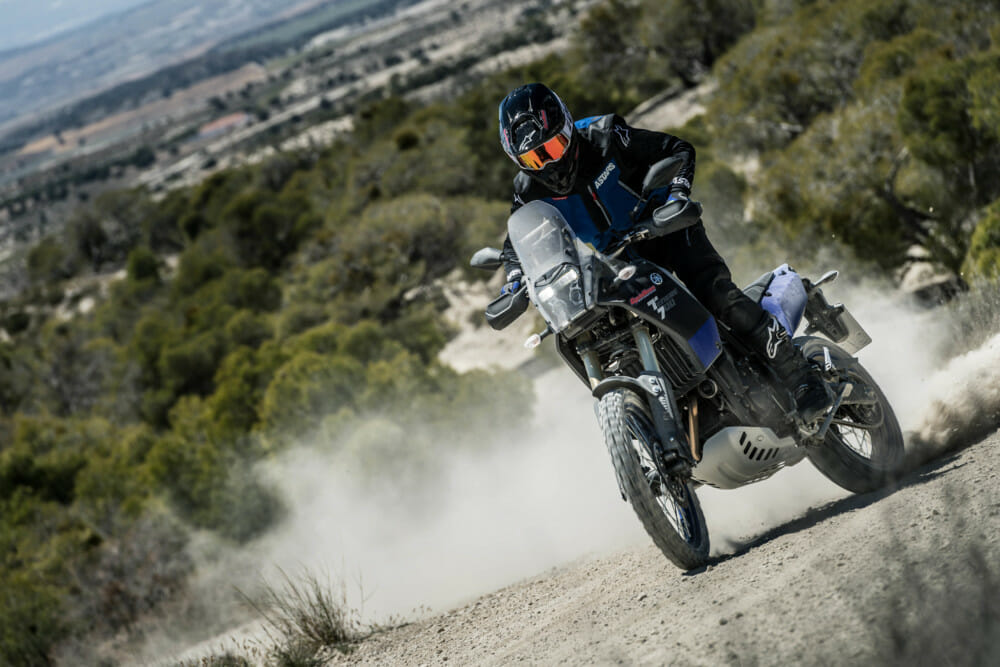 Unfortunately, the Tenere 700 won’t be gallivanting around the countryside in North America anytime soon.
Unfortunately, the Tenere 700 won’t be gallivanting around the countryside in North America anytime soon.
Yamaha Tenere 700 Wrap-Up
Yamaha teased us with the epic T7 and again with the World Raid. All the while, they did an outstanding job of not ruining the rally-inspired look and, it seems, performance of a middleweight adventure machine with real off-road potential.
Now that we’ve tasted Europe’s first flavor of the Tenere 700, we’re even more. This is a bike with incredible potential in the North American market. It’s simplistic and seems to be fighting above its weight class with a fun, nimble and sporty ride. If it comes in at the right price, it will win at dealerships as a big-time upgrade to the dual-sport stalwarts and truly entry-level models and can compete on performance potential with more premium offerings.
If we get anything close to what we rode in Europe, and we should, adventure customers will have a few color options and host of useful accessories to make these bikes perfect for them. We highly recommend the taller “Rally” seat—it adds some space for your legs to stretch out when sitting—if your inseam allows it. There’s also a lowering setup for shorter riders. But we still have to wait and see on those.
While we don’t know exactly what we’re going to get when the Tenere 700 lands in North America, we know we can’t wait to find out.
Again.CN
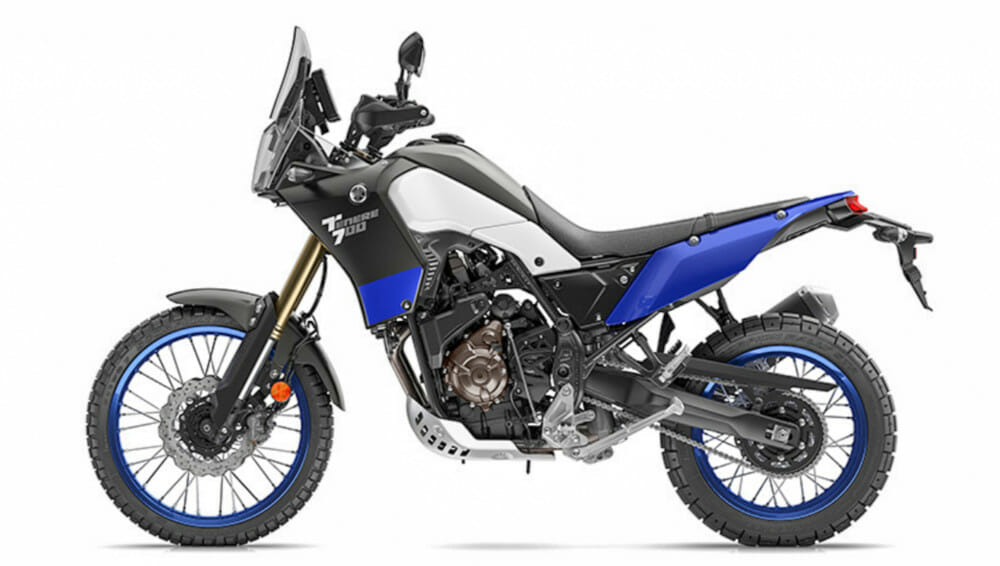
2021 Yamaha Tenere 700 Specifications
| Engine: |
Liquid-cooled, DOHC, Parallel Twin 4 valves per cylinder |
| Bore x Stroke: |
80mm x 68.6mm |
| Displacement: |
689cc |
| Compression Ratio: |
11.5:1 |
| Horsepower (Rear Wheel, claimed): |
72.4 hp @ 9,000 rpm |
| Torque (claimed): |
50 lb-ft @ 6,500 rpm |
| Transmission: |
6-speed, wet multi-plate clutch |
| Final Drive: |
Chain |
| Front Suspension: |
KYB 43mm inverted fork, fully adjustable |
| Rear Suspension: |
KYB Single shock, adjustable preload (w/remote adjuster) and rebound damping |
| Front Wheel Travel: |
8.3 in. |
| Rear Wheel Travel: |
7.9 in. |
| Front Brake: |
Brembo, dual 282mm hydraulic disc; selectable ABS (on/off) |
| Rear Brake: |
Brembo, 245mm hydraulic disc; selectable ABS (on/off) |
| Front Tire: |
90/90R21 Pirelli Scorpion Rally STR |
| Rear Tire: |
150/70R18 Pirelli Scorpion Rally STR |
| Rake/Trail: |
27.0°/4.13 in. |
| Wheelbase: |
62.8 in. |
| Seat Height: |
34.6 in. |
| Curb Weight (Claimed): |
449.7 lbs. |
| Fuel Capacity: |
4.2 gal. |
| Colors: |
Ceramic Ice |
| Warranty: |
Warranty 1 Year (Limited Factory Warranty) |